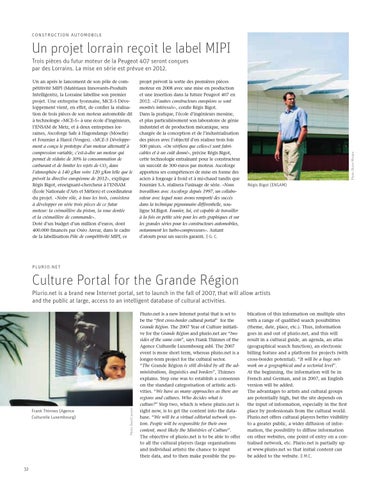06_30-78_news
12.05.2006
21:25 Uhr
Page 32
CONSTRUCTION AUTOMOBILE
Un projet lorrain reçoit le label MIPI Un an après le lancement de son pôle de compétitivité MIPI (Matériaux Innovants-Produits Intelligents), la Lorraine labellise son premier projet. Une entreprise lyonnaise, MCE-5 Développement vient, en effet, de confier la réalisation de trois pièces de son moteur automobile dit à technologie «MCE-5» à une école d’ingénieurs, l’ENSAM de Metz, et à deux entreprises lorraines, Ascoforge Safe à Hagondange (Moselle) et Fournier à Harol (Vosges). «MCE-5 Développement a conçu le prototype d’un moteur alternatif à compression variable, c’est-à-dire un moteur qui permet de réduire de 30% la consommation de carburant et de limiter les rejets de CO2 dans l’atmosphère à 140 g/km voire 120 g/km telle que le prévoit la directive européenne de 2012», explique Régis Bigot, enseignant-chercheur à l’ENSAM (École Nationale d’Arts et Métiers) et coordinateur du projet. «Notre rôle, à tous les trois, consistera à développer en série trois pièces de ce futur moteur: la crémaillère du piston, la roue dentée et la crémaillère de commande». Doté d’un budget d’un million d’euros, dont 400.000 financés par Oséo Anvar, dans le cadre de la labellisation Pôle de compétitivité MIPI, ce
projet prévoit la sortie des premières pièces moteur en 2008 avec une mise en production et une insertion dans la future Peugeot 407 en 2012. «D’autres constructeurs européens se sont montrés intéressés», confie Régis Bigot. Dans la pratique, l’école d’ingénieurs messine, et plus particulièrement son laboratoire de génie industriel et de production mécanique, sera chargée de la conception et de l’industrialisation des pièces avec l’objectif d’en réaliser trois fois 500 pièces. «On vérifiera que celles-ci sont fabricables et à un coût donné», précise Régis Bigot, cette technologie entraînant pour le constructeur un surcoût de 300 euros par moteur. Ascoforge apportera ses compétences de mise en forme des aciers à forgeage à froid et à mi-chaud tandis que Fournier S.A. réalisera l’usinage de série. «Nous travaillons avec Ascoforge depuis 1997, un collaborateur avec lequel nous avons remporté des succès dans la technique pignonnaire différentielle, souligne M.Bigot. Founier, lui, est capable de travailler à la fois en petite série pour les arts graphiques et sur les grandes séries pour les constructeurs automobiles, notamment les turbo-compresseurs». Autant d’atouts pour un succès garanti. || G. C.
Photo: Olivier Minaire
Trois pièces du futur moteur de la Peugeot 407 seront conçues par des Lorrains. La mise en série est prévue en 2012.
Régis Bigot (ENSAM)
P L U R I O. N E T
Culture Portal for the Grande Région
Frank Thinnes (Agence Culturelle Luxembourg)
32
Photo: David Laurent
Plurio.net is a brand new Internet portal, set to launch in the fall of 2007, that will allow artists and the public at large, access to an intelligent database of cultural activities. Plurio.net is a new Internet portal that is set to be the “first cross-border cultural portal” for the Grande Région. The 2007 Year of Culture initiative for the Grande Région and plurio.net are “two sides of the same coin”, says Frank Thinnes of the Agence Culturelle Luxembourg asbl. The 2007 event is more short term, whereas plurio.net is a longer-term project for the cultural sector. “The Grande Région is still divided by all the administrations, linguistics and borders”, Thinnes explains. Step one was to establish a consensus on the standard categorisation of artistic activities. “We have as many approaches as there are regions and cultures. Who decides what is culture?” Step two, which is where plurio.net is right now, is to get the content into the database. “We will be a virtual editorial network system. People will be responsible for their own content, most likely the Ministries of Culture”. The objective of plurio.net is to be able to offer to all the cultural players (large organisations and individual artists) the chance to input their data, and to then make possible the pu-
blication of this information on multiple sites with a range of qualified search possibilities (theme, date, place, etc.). Thus, information goes in and out of plurio.net, and this will result in a cultural guide, an agenda, an atlas (geographical search function), an electronic billing feature and a platform for projects (with cross-border potential). “It will be a huge network on a geographical and a sectorial level”. At the beginning, the information will be in French and German, and in 2007, an English version will be added. The advantages to artists and cultural groups are potentially high, but the site depends on the input of information, especially in the first place by professionals from the cultural world. Plurio.net offers cultural players better visibility to a greater public, a wider diffusion of information, the possibility to diffuse information on other websites, one point of entry on a centralised network, etc. Plurio.net is partially up at www.plurio.net so that initial content can be added to the website. || M.C.
